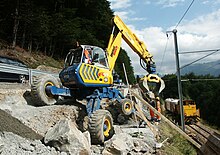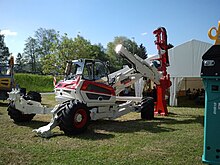Walking excavator

The walking excavator (also known as a spider excavator ) is a construction machine and is assigned to the standing excavator because it mainly carries out work while stationary. Similar to a conventional hydraulic excavator , the walking excavator has a rotating upper structure on which the boom and attachment are located. The construction of the undercarriage is different. Instead of a conventional wheel or crawler chassis, walking excavators are equipped with four walking legs. Both wheels and outriggers can be mounted on the legs. With the help of these independently controllable walking legs, it is possible for the operator to stand securely and carry out work processes even in difficult terrain or in the river bed . Walking excavators are used in earthworks , forestry or landscaping .
The largest dragline excavators in open-cast mining are also known as walking excavators . They have a round base and can walk slowly in a straight line on a reasonably level surface with two to four “shoes”. It is steered by swiveling the entire crane superstructure on which the shoes are mounted before the next step.
history
The walking excavator was invented in 1965 and 1966 by the two companies Kaiser and Menzi. In 1965 Kaiser manufactured the prototype, the MUK 2000. The first serial product was the Kaiser MUK 3000, which was developed by Kaiser in Liechtenstein and built by the then 69-year-old Swiss manufacturer Ernst Menzi (1897–1984). MUK stood for Menzi and Kaiser. Due to differences, the two companies went their separate ways, Menzi sold the walking excavator under the name Menzi Muck . Initially, the devices were very simply designed with little comfort for the driver. The Neue Zürcher Zeitung wrote at the end of the 1960s that the walking excavator was “a digging device with spider legs and the charm of a poorly lit telephone booth.” In 1967 the MM 3000 walking excavator from Menzi Muck achieved a tearing force of 30 with an engine output of just under 30 kW kN and a maximum reach of 4.6 m. Over the years, the devices at both Kaiser and Menzi have been further developed and their performance increased.
There are currently three main manufacturers: Kaiser, Menzi and Euromach.
Parameters
The machines have between 60 and 100 kW and have an operating weight of between 6 and 10 t . The grave vessel (for example a backhoe ) can hold up to 0.5 m³ . Walking excavators reach a ground clearance of up to 1.5 meters and a fording depth of 2 meters.
Locomotion
The walking excavator has four walking legs on its undercarriage, which can be adjusted in horizontal and vertical direction and length to the slope. If the wheels are raised on the front outriggers, the excavator comes to a standstill here. On some machines only the rear booms are equipped with wheels. In light terrain, these machines can drive on their wheels, provided that all booms are equipped with them.
To walk, the driver reaches out with the boom and presses against the ground so that the front boom lifts off. If the boom is now used, the entire machine rolls on the rear wheels (possibly supported by the wheel drive) towards the boom. By lifting the boom, the front striding legs are set down again and the next step can follow. The vehicle moves backwards by pushing it away. The direction is changed by rotating the superstructure after lifting, which allows the undercarriage to roll sideways at an angle. The excavator can work on slopes of up to 45 degrees (corresponds to 100 percent incline) or climb vertical steps of several meters, as in Wetten, dass ..? demonstrated. Walking excavators can also heave themselves onto a truck bed and then be transported to another location.
The walking excavator is also available in a modified version with four wheels so that it is easier to move and move the machine. The most advanced version has four wheels of the same size and four-wheel drive .
use
The device is suitable for use in rough terrain, such as can be found in the forest or on slopes. With the appropriate equipment, the walking excavator can be used as a wood harvester . With the appropriate equipment, walking excavators can also be used as floating excavators. The walking excavator can also be used as a rescue and rescue device thanks to its ability to work far within inaccessible fields of rubble or rubble. The Technische Hilfswerk (THW) is already using several generations of these devices. They are sometimes referred to there as the rescue spider.
The devices are transported with the help of trucks or flatbed trucks . The walking excavator can climb onto and off the loading area itself.
The many degrees of freedom of the walking excavator place very high coordination demands on the driver. Electronic aids make operation easier.
See also
- List of construction machinery and construction equipment
- List of construction machinery manufacturers
Web links
Individual evidence
- ^ Kaiser Liechtenstein: 50 years of Kaiser walking excavators 1965-2015. Kaiser, accessed February 19, 2019 .
- ^ History. Menzi Muck's website , accessed March 12, 2006.
- ^ Willi Dolder: 1000 excavators and other construction machines. NGV-Verlag, 2006, ISBN 978-3-625-10374-5 , page 275.
- ↑ Horst König: Maschinen im Baubetrieb: Fundamentals and Applications , 2nd expanded edition, Teubner Verlag, 2008, ISBN 978-3-8351-0250-7 , page 109f
- ↑ Bet that ..? 161. Broadcast on March 12, 2006
- ↑ Diploma thesis on the walking excavator, abstract and video http://web.utanet.at/amannalb/bagger/ [12. March 2006] and Menzi Muck walking excavator - Tiefbau Live 2008 video




